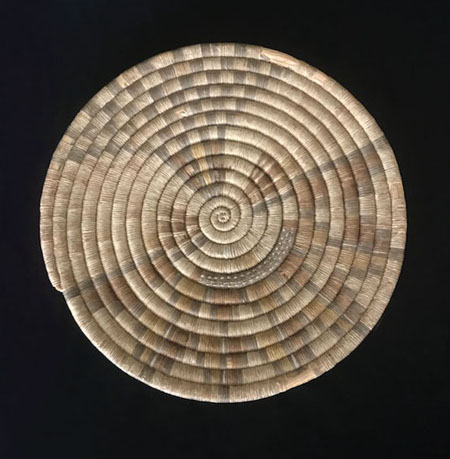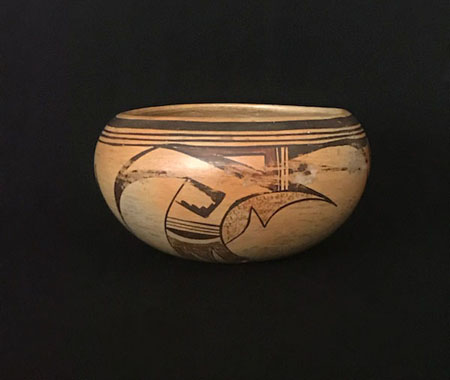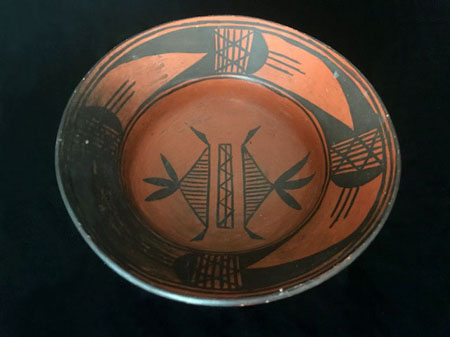One copy of the Hopi Regalia is available for checkout. This artifact kit contains examples of Hopi artifacts. These artifacts have been carefully select to be used to create lesson plans to expose students to primary resources. Artifacts can be used to show students how to observe and analyze objects for understanding more about the past. Below are some images and information about the artifacts
Hopi Woven Platter
This platter was made using the coiling technique. The technique uses two elements, the warp and the weft, that work together to create the weave. Coiled baskets and platters such as this one use the warp as the foundation material and the weft as the visibly coiled material. Hopi women utilize the yucca plant as the material for both the weft and warp. From the yucca plant, Hopi women can create beautiful designs using colors of white, yellow, green, red, and black. Special consideration is given to the collection of the yucca plant, as the freshest newly grown stems are needed for basketry.

Sityatki Revival: Yellow-Orange Pot
Revival of pottery production in the Modern Hopi nation came from Hano Village on the First Mesa. Pottery production almost disappeared entirely by the 18th century due to centuries of cultural suppression by the Spanish. While utilitarian pottery continued to be produced among most Hopi villages, pottery produced in the Sityatki style was revived for selling during the 20th century. A local trader near Hano Village suggested that the potters replicate the pottery that had been found at the pre-contact site of Sityatki. This was mostly likely due to the increased demand among "collectors" and tourists who visited these trading posts looking for native artwork and artifacts. The pot pictured below has been decorated in the Sityatki style. Skyband motifs, represented by one thick line and three thin lines, are painted along the edge of the rim. Two abstract birds in geometric design, wrap around the outside of the pot.

Redware Bowl
Starting in the 1930s, Hopi potters began producing redware pottery similar to the pre-contact styles associated with Ancestral Puebloans of the Kayenta region. The bowl pictured below is a combination of both the redware pottery and sityatki design style. The single line that runs parellel to the edge of the bowl is known as a sky-band. Many example exist including double bands and thick bands. The simplest form is represent as extending across the entire inside of the bowl. The more complicated run parelle to the rim. For this replica, three sky bands are depicted. The first is a single band along the rim. The second is a single band alng the inner dip of the bowl. The final sky band is a rectangle with a v pattern and single line running through the middle. The depiction of the sky abnd may present the path of the sun through the sky or the milky way.
The skyband is often depicted with a figure or figures attached/suspended from it. These figures represent birds. The birds can be elaborately drawn or geometircally rendered with little resemblance to actual birds. For this particular bowl, the bird is rendered as being suspended longitudinally to the sky band. It is one of the simplest designs of the bird. The three short parallel lines present the tail feather. The two large black triangles most likely represent the beak/head of the bird. If you look carefully you will notice that this design repeats four times. The striped triangles that surround the third sky band in the center of the bowl do not have any known connection to any designs on prehistoric Hopi pottery. They were most likely designed and added by the artist themselves, suggesting that this bowl was most likely made for the tourist market.

Sources:
- Helga Teiwes. 1996. Hopi Basket Weaving: Artistry in Natural Fibers. Tucson: The University of Arizona Press.
- Treasures from the Basement: Pottery of the Hopi Nation(opens in new window)
- Walter Fewkes. 1973. Designs on Prehistoric Hopi Pottery. New York: Dover Publications, Inc.
